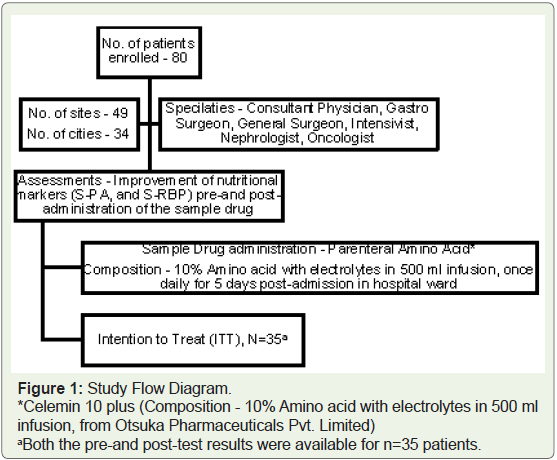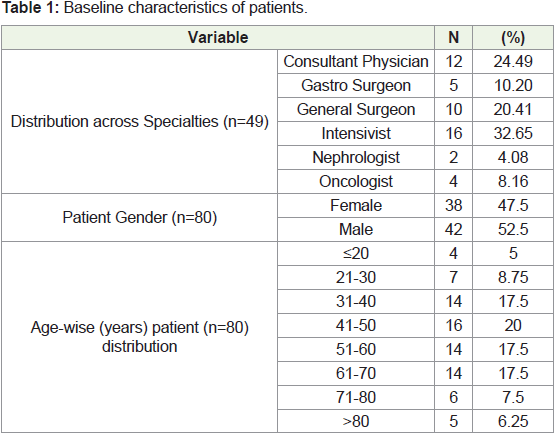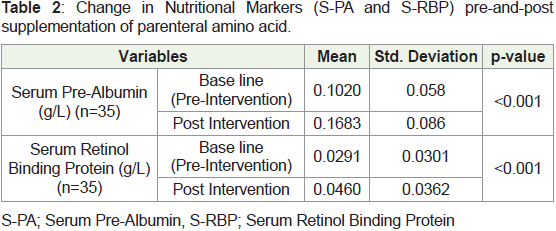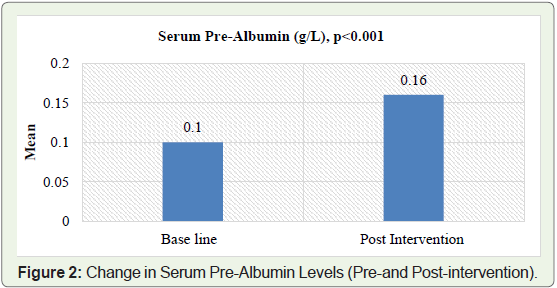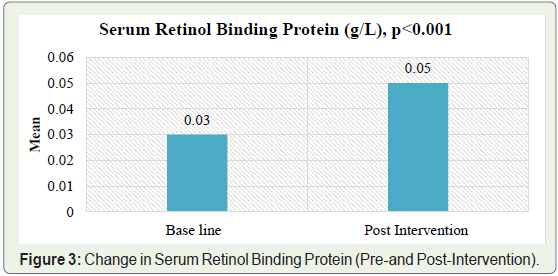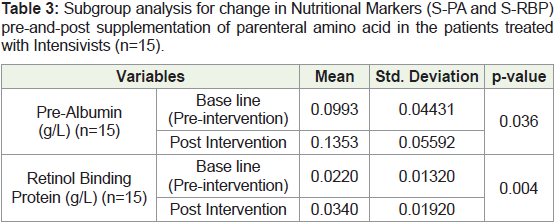Research Article
Efficacy and Safety of Parenteral Amino Acids in Hospitalized Malnourished Patients: A Multicentric Case-Series
Sheth H1*, Mishra PK2, Sharma R3, Kumar M4 and Shukla H5
1Consultant Surgeon, Saifee Hospital, Apollo Spectra Hospital, Bhatia Hospital, Conwest Hospital & Manjula Badani Jain Hospital,
Mumbai, India
2Consultant Critical Care, Shree Aggarsain International Hospital, New Delhi, India
3Consultant Surgeon, New Delhi, India
4Medical Superintendent, Pushpanjali Medical Center, Delhi, India
5Consultant Oncosurgeon, BLK-Max Super specialty Hospital, New Delhi, India
*Corresponding author: Sheth H, Consultant Surgeon, Saifee Hospital, Apollo Spectra Hospital, Bhatia Hospital, Conwest Hospital
& Manjula Badani Jain Hospital, Mumbai, India; E-mail: harsh86sheth@gmail.com
Article Information: Submission: 06/08/2022; Accepted: 03/09/2022; Published: 05/09/2022
Copyright: © 2022 Sheth H, et al. This is an open access article distributed under the Creative Commons Attribution License, which
permits unrestricted use, distribution, and reproduction in any medium, provided the original work is properly cited.
Abstract
Background & Objective: Globally, malnutrition in hospitalized patients is increasing, with prevalence up to 30-50%. It is associated with a higher risk of
adverse outcomes, including morbidity, mortality, length of hospital stay, and compromised quality of life. In India, almost two-fifths of the patients admitted to
tertiary care hospitals are reported to be malnourished. Studies have suggested using nutritional markers like serum pre-albumin (SPA) and visceral protein
markers like serum retinol-binding protein (S-RBP) to evaluate the nutrition status of malnourished patients. Guidelines recommend supplementing parenteral
amino acids to manage the protein status in hospitalized patients with malnutrition.
This case series study aims to demonstrate the efficacy and safety of parenteral amino acids in malnourished patients admitted to the hospital ward and
their impact on improving nutritional markers e.g., S-PA and S-RBP.
Methods: This multicentric case series study enrolled 80 patients admitted to the hospital ward across 49 Indian sites. Parenteral amino acid
supplementation was administered intravenously once daily for five days. The primary outcomes were changes in the nutritional laboratory markers S-PA and
S-RBP for improvement in nutritional status in enrolled malnourished patients.
Results: The pre-and post-assessment data for nutritional laboratory markers were available for 35 patients. A statistically significant increase was
observed in the levels of S-PA and S-RBP. Additionally, similar improvements were observed in a subgroup analysis of patients treated by intensivists.
Conclusion: The results from this case series demonstrated that administering parenteral amino acid significantly improves the nutritional laboratory
markers S-PA and S-RBP in hospitalized patients with malnutrition. A similar benefit was also observed in the subgroup of patients treated by the intensivists,
suggesting a positive role of parenteral amino acid supplementation in critically ill patients.
Keywords
Critically ill patients, Hospitalized patients, Parenteral amino acids, Serum pre-albumin, Serum retinol-binding protein
Introduction
Malnutrition, in simple words, is any nutritional imbalance [1].
Academy of Nutrition and Dietetics (AND) and the American Society
for Parenteral and Enteral Nutrition (ASPEN) define malnutrition as the presence of any two or more of the entities, including insufficient
energy intake [1-4], weight loss [1,5-8], loss of muscle mass [8-9], loss
of subcutaneous fat [8-9], localized or generalized fluid accumulation
[8-9], or decreased functional class [8,10-12]. Globally, malnutrition in the hospital setting affects approximately 30-50% of patients
accounting for a significant public health problem today [8-9,13-16].
Many patients enter the hospital with malnourished status or at
risk of malnutrition. Further, the nutrition status of these critically
ill patients declines during their stay, putting them at a higher risk
for adverse outcomes, including increased morbidity, mortality, and
length of hospital stay, with reduced quality of life following a hospital
discharge [13,17-18].
European Society for Clinical Nutrition and Metabolism (ESPEN)
- 2019 guidelines on clinical nutrition in the intensive care unit
recommend that every critically ill patient staying for more than
48 h in the ICU be considered at risk for malnutrition. However, as
per ESPEN, no specific ICU nutritional score has been validated so
far and nutritional risk screening [NRS 2002] and the malnutrition
universal screening tool (MUST) have the strongest predictive value
for mortality, and they are the easiest and quickest to calculate [19].
On the contrary, the Society of Critical Care Medicine (SCCM)
and the American Society for Parenteral and Enteral Nutrition
(ASPEN) expert consensus suggests a determination of nutrition risk
(e.g., nutritional risk screening [NRS 2002], NUTRIC score) to be
performed on all patients admitted to the ICU for whom volitional
intake is anticipated to be insufficient [20-21].
Traditionally termed as a nutritional marker, serum albumin and
pre-albumin quantify the amount of plasma circulating proteins and,
thereby, thought to reflect nutrition status. Nutrition risk is primarily
described as developing malnutrition and/or poor clinical outcomes
if nutrition support is not provided. The decline in serum albumin
and pre-albumin must be recognized as inflammatory markers
associated with “nutrition risk” in nutrition assessment rather than
with malnutrition per se [22-23].
As per the guideline recommendations, a protein intake of 1.2 to
2 g/kg weight per day should be allowed for most patients admitted
to ICU, and ongoing evaluation of the adequacy of protein provision
[20]. Allingstrup, MJ., et al., in their prospective observational
cohort study ranked 113 ICU patients into three groups according
to the amount of protein& amino acid (AA) provided; (Low; n=37,
Medium; n=38, High; n=38). It was observed that patients in the
high-protein group had a significantly lower risk of hospital mortality.
Although overall, I.C.U. mortality did not differ, and the Kaplan-
Meier survival probability at day 10 differed among protein groups
(low, 49%, medium, 79%, and high, 88%; p = 0.021). Several recent
observational studies support a higher protein goal demonstrating an
association between adequate protein intake (i.e., at least 1.2 to 1.5 g/
kg/day) and improved clinical outcomes in critically ill patients. [24-25] Visceral protein markers, such as transthyretin (TTR) and retinolbinding
protein (RBP), have been associated as an indicator of protein
malnutrition. Liu, K. et al., in their cross-sectional study including
682 elderly patients observed that low levels of retinol-binding protein
were associated with an increased risk of sarcopenia in elderly general
hospitalized patients [26].
However, from the view of the Indian setting, the available data
is still inconclusive on parenteral amino acid supplementation in
hospitalized patients with malnourishment and their impact on improving the nutritional markers like serum pre-albumin and
retinol-bindingprotein. This case series aims to demonstrate the
effectiveness of parenteral amino acids in malnourished patients
admitted to the hospital ward.
Methods
Design & Setting:
A multicentric case series study was conducted across 34 cities of
India from August 2021 to November 2021 on malnourished patients
admitted to the hospital ward. After consent from the patients, the
following basic information was collected: height, weight, changes in
food intake, and changes in body weight.Sample:
A total of 80 patients were enrolled with malnourishment and
admitted to the hospital ward. Inclusion criteria were as follows:
patients between 18 years to 90 years admitted to the hospital ward.
The enrollment was done across India and distributed across 49 sites.Intervention and Outcomes:
In each admitted patient (N=80), the parenteral amino acid
(Celemin 10 Plus from Otsuka Pharmaceutical India Private Limited;
Composition - 10% Amino acid with electrolytes in 500 ml infusion)
was administered as an intravenous infusion once daily (OD) for 5
days as per the hospital protocol. Two nutritional laboratory markers
were evaluated for improvement in nutritional status in enrolled
malnourished patients - a. Serum Pre-albumin (S-PA), b. Serum
Retinol Binding Protein (S-RBP). Both these markers have short halflives
and changes in serum levels can be detected within 4-5 days.
Changes in both parameters are known to correlate with nutrition
status and prognosis in hospitalized patients.All the patients had undergone a laboratory test for these two
markers pre- and post-administration of the parenteral amino
acid (Celemin10 Plus) for 5 days. The tests were conducted by SRL
Diagnostics.
The primary objective of the case series was to study the effectiveness of parenteral amino acids in malnourished patients
admitted tothe hospital ward by the evaluation of changes in
nutritional markers (S-PA and S-RBP) levels. The study flow is
presented in Figure 1.
Figure 1: Study Flow Diagram.
*Celemin 10 plus (Composition - 10% Amino acid with electrolytes in 500 ml
infusion, from Otsuka Pharmaceuticals Pvt. Limited)
aBoth the pre-and post-test results were available for n=35 patients.
Statistical Analysis:
The major outcomes analyzed statistically were as following: a.
Prevalence/incidence of malnourishment age-wise, b. Prevalence/
incidence of malnourishment sex-wise, c. Nutritional laboratory
markers (S-PA and S-RBP) for improvement in nutritional status in
enrolled malnourished patients.The data set was analyzed using Statistical Package for the Social
Sciences (S.P.S.S.) Ver. 25. The quantitative variables were expressed
as mean and standard deviation (Age, S-PA, S-RBP). The categorical
variables were defined in number (n) and percentage (%) (Age groups,
sex). Paired t-test was considered for comparing all the means. For
comparison of categorical variables Chi-Square test or Fisher exact
test (in case of sample size <6) was used. A p-value of <0.05 was
considered statistically significant, and a p-value of<0.001 was highly
significant.
Results
Baseline Characteristics:
Out of Eighty malnourished patients admitted to the hospital
ward, 42 (52.5%) were male, and 38 (47.5%) were female. Age ranges
from 18-90 years, with a mean age of 51.22 years (Standard Deviation;
SD - 17.66 years).The baseline characteristics of the sample and distribution of
specialties are presented in Table 1. Amongst all the specialties,
the subgroup of Intensivists represented the major category, n=16
(32.65%). The age-wise prevalence demonstrates that the incidence
of malnourishment was highest amongst the age group of 41-50 years.
Outcome Analysis:
The data of both pre-and post-assessment for nutritional laboratory markers (S-PA,S-RBP) was available for n=35 patients, whereas the
rest of the patients (n=45) were not included in the analysis due to
various reasons, e.g., patients lost to follow-up, withdrawal of consent
by the patient, lack of availability of test results, etc. The parenteral
amino acid supplementation (10% Amino acid with electrolytes in
500 ml infusion) was administered once daily (OD) for 5 days to all
these 35 patients, and the outcomes in the change in the nutritional
laboratory markers are presented in Table 2 and Figure 2, and Figure 3.
Table 2: Change in Nutritional Markers (S-PA and S-RBP) pre-and-post
supplementation of parenteral amino acid.
In the patient population, where both pre-and post-intervention
data were available, a statistically significant improvement was
observed in the levels of both S-PA (pre-intervention; 0.102±0.058,
post-intervention; 0.168 ± 0.086, p<0.001) and S-RBP (preintervention;
0.0291±0.030, post-intervention; 0.460 ± 0.036,
p<0.001).
In a subgroup, analysis was conducted for the group of patients
(n=15) treated by Intensivists. A significant increase in SPA [preintervention;
0.0993±0. 04431, post-intervention; 0.1353±0.05921,
p=0.036] and S-RBP [pre-intervention; 0.022±0.0132, postintervention;
0.034± 0.0192, p=0.004). The details are shown in Table 3.
Discussion
This multicentric case series was carried out to evaluate the role
of parenteral amino acid supplementation in malnourished patients
admitted to the hospital ward based on changes in nutritional
laboratory markers (S-PA and S-RBP).
The results (as discussed above) demonstrate the benefits of
parenteral amino acid supplementation on the nutritional status
of this patient population. Furthermore, the subgroup analysis of
patients treated by intensivists indicates a similar benefit, ascertaining
the importance of parenteral amino acids in critically ill patients.
There is growing evidence of the role of parenteral amino acids
supplementation in hospitalized and critically ill malnourished
patients, with its ability to deliver anoptimal amount of amino acids
and where the enteral nutrition (EN) is refused, inappropriate, or
demonstrated to be incapable of meeting the patient’s nutritional
requirements [27].
A 2014 study by Aimova PP, et al. on the importance and dosage of
amino acids in nutritional support of various pathological conditions
in I.C.U. patients showed that amino acid requirements in parenteral
nutrition (P.N.) are higher when the patient is stressed/traumatized/
infected than in the unstressed state. The study results demonstrated
that 2.0-2.5 g protein/kg/day is safe and can be an optimal dose for
the most critically ill adults to decrease the risk of morbidity and
mortality [28].
In a systematic review by Wischmeyer PE, et al. 26 studies
involving 2,484 patients demonstrated a strong trend towards
reducing infectious complications, I.C.U. length of stay (L.O.S.), and
a significant reduction in hospital L.O.S. establishing that parenteral
amino acid supplementation, as a component of nutrition support,
should be considered to improve outcomes in critically ill patients
[29].
As per the ESPEN guidelines recommendation on clinical nutrition
in the intensive care unit, parenteral amino acid supplementation may
be considered in patients who cannot be fed adequately enterally, and
a balanced amino acid mixture should be infused at approximately
1.3-1.5 g/kg/day (ideal body weight) [19].
However, there are some limitations to this case series study.
Firstly, the appropriate tracking of the nutritional risk and clinical
outcomes after discharge were not evaluated. Secondly, more accurate
data could be obtained by expanding the sample size across different
centers of India.
Conclusion
The results of this multicentric case series showed that the
administration of parenteral amino acids (Celemin 10 Plus, containing
10% amino acid with electrolytes in 500ml infusion) significantly
improves the nutritional markers - serum pre-albumin (S-PA) and
serum retinol-binding protein (S-RBP) in hospitalized patients
with malnutrition. Additionally, the benefits were also observed in
the subgroup analysis of the patients under critical care treated by
intensivists, suggesting nutritional benefits of parenteral amino acid
administration in critically ill patients.
Acknowledgment
The authors would like to express sincere gratitude to all the
investigators across the sites for their support and cooperation.

